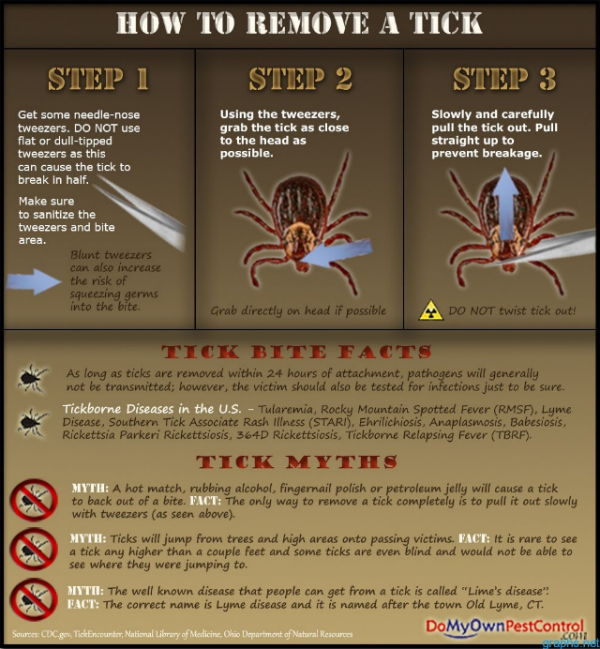 Besides chiggers and mosquitoes, I don’t think there is any critter I loath more than ticks. Aside from the obvious “creepy crawler” factor, they also suck your blood, leave hideous bites, and spread debilitating diseases. I don’t think God, man, or nature would care if these creatures disappeared from the face of the Earth.
Besides chiggers and mosquitoes, I don’t think there is any critter I loath more than ticks. Aside from the obvious “creepy crawler” factor, they also suck your blood, leave hideous bites, and spread debilitating diseases. I don’t think God, man, or nature would care if these creatures disappeared from the face of the Earth.
But while they’re still here, we just have to do our best to avoid them. When hiking in the wilderness it’s important to stay away from long grass and thick brush. For the most part, staying on the trail is a surefire way to avoid them. It’s also a good idea to wear bright clothing so that it’s easier to spot them on your body.
Make sure to wear long sleeve clothes and if you can, tuck your pants into your shoes. That by itself is usually enough to keep them away from your skin, provided you do regular body checks to spot them before they crawl under your clothes.
You can also use a bug repellent like DEET, though it’s probably not a healthy substance to slather onto your skin. If you live in the city and only see the wilderness a couple of times a year, this may not be a problem. But if you live in a suburban or rural area that is infested with ticks, you’re looking at a chronic exposure.
In that case, it might be wise to apply it to your clothing as opposed to your skin, which should be almost as effective. Or if you’d like you can take the natural route, and use some essential oils. By all accounts, Rose Geranium is the most popular natural substance for tick repellent.
Once you’re indoors, you should wash your clothes and take a shower. This is a good time to do a final body check. Use a mirror to check every nook and cranny. Inspect your waist since most ticks will have a hard time getting past the waistband of your pants. You’ll also want to check your armpits, inner arm, behind the knees, behind your ears, hairline and scalp, and finally your crotch.
If after all that, you still managed let one of those buggers latch onto you, it’s important to remove the tick as soon as possible. The longer you wait, the harder they are to remove, but more importantly you’ll be reducing the risk of being exposed to disease. Pathogens like Lyme disease are typically spread after the tick has been there for more than 24 hours, so there’s no time to waste (who am I kidding, nobody waits to get rid of these disgusting creatures).
The proper procedure for tick removal is simple enough, and could be best described with this handy infographic.
And finally, if you have a serious tick infestation in your own back yard, you probably don’t want to go through that whole prevention process every time you step out your of backdoor. It’s hard to say if you could completely eliminate a tick infestation, but there are some very simple ways to thin their population. The method I’m going to explain is non toxic, and probably costs about the same as a pesticide treatment.
The first thing you’ll need is a cheap container. It could be some tupperware from the dollar store or a plastic bottle. Line the edge with either double-sided tape or packing tape with the sticky side up. Place a small piece of dry ice inside the container, and set it anywhere in your backyard that you might think is infested.
As the dry ice sublimates into the air, it gives off CO2 which attracts the ticks. Fun fact, this is how ticks find you. They can sense the air you exhale. So as the dry ice dissolves, they’ll come crawling to your container, and they should get stuck to the tape. If you’re not too squeamish you can see a perfect example of this technique here.
So there you have it. I guess this guide wasn’t as quick as I thought it’d be, but it sure was dirty. Hopefully now you can enjoy your outdoor adventures without worrying about these nasty critters tagging along.


Guinea fowl are famed for their appetite for ticks, but they can be rather annoying. To remove ticks, I rotate the tick counter clockwise while gently pulling. So far so good, no tick heads left in me, the family, dogs, or other critters.
Lyme is much worse than mainstream medical knows. The tests miss 99% of lyme and, once you have it, you have it. 3 weeks on antibiotics doesn’t touch lyme. It’s a destroyer of lives.
So Disqus
what am I supposed to do? I’m currently on Doxicycline for 3 weeks after finding a little deer tick in arm, and now today another, and I need to wait a few weeks before I can be tested, your negative input does not give me hope, is there anything else you can add to give hope?
Govt sponsored Disease to keep the MIC thriving.